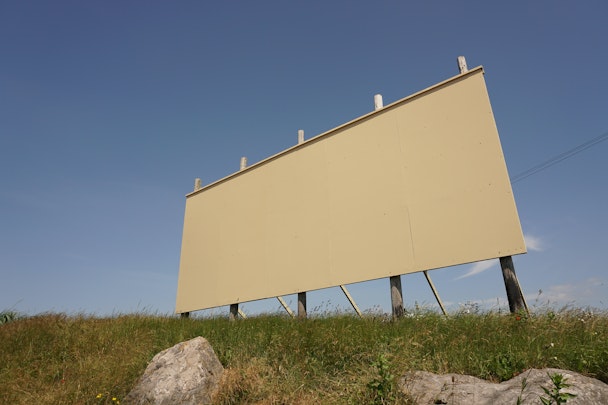Want to change consumer behavior? Take a fresh look at out-of-home
Posterscope’s Scott Green argues that behavioral science and out-of-home advertising are a match made in heaven.

Out-of-home: the perfect medium for behavior change? / Gavin Allanwood via Unsplash
“I no longer listen to what people say, I just watch what they do. Behavior never lies.” – Winston Churchill
Understanding consumer behavior provides the necessary insight to craft compelling marketing campaigns, convincing people to choose your brand.
But influencing consumer behavior is not easy. Old habits die hard, and consumers are stubborn when adopting any innovation that requires behavioral change. Technology and data, meanwhile, have transformed how we connect and interact with the world, and we marketers continue to adopt new strategies (omnichannel, mobile-first and online-to-offline) to influence consumer behavior through FOMO, social norms and the urgency effect.
But one of the most powerful ways to get someone to change their behavior is to suggest that everyone else is doing something. Human beings generally like to fit in. We thrive when part of a stable social group, and conforming is a tried and tested approach to maintaining equilibrium. (Strategists are outliers to this notion, but you get my point.)
FOMO and OOH
So, changing human behavior is not about changing an individual’s opinion, but suggesting that everyone around them has already changed theirs. Marketing is littered with examples of this social proofing in play.
One famous example is when the UK government’s nudge unit sent reminders from Revenue and Customs to people with outstanding taxes, stressing that other people living in the same area had already paid theirs.
This ‘localization’ of social norms reveals this strategy's power and demonstrates how important out-of-home (OOH) advertising is for brands wishing to drive behavioral change. The OOH media infrastructure is designed around consumer behavior patterns, lending itself to behavioral media planning, with targeting triggers around locations, communities, and context. With diverse formats in multiple environments and social settings, OOH is ideal for advertisers looking to shift perceptions and attitudes – and drive consumers toward their brands.
Consumer behavior and beliefs are changing fast. The cost-of-living crisis and climate change are altering consumers’ mindsets and motivations. To keep up and influence these changes, brands must understand consumers both from a demographic and psychographic perspective to develop successful campaigns.
Changing hearts and minds, out-of-home
Behavioral science studies how emotions, the environment, and social factors influence our decisions. It suggests that to influence consumer behavior, brands must analyze beliefs, values and need states more closely, and align messages to consumer mindsets.
Take climate change: there’s an opportunity for brands to shape emerging habits around sustainability through product innovation, or to reinforce new habits like the ‘staycation’ through contextual cues.
In the current socio-economic climate, brands should consider OOH a public and trusted medium to leverage familiarity from habitual media consumption patterns and use premium inventory to build brand trust. Using environments where people habitually cluster, such as rail stations, city centers, or shopping malls can aid social proofing and amplify impact.
Familiar settings also offer the opportunity for disruption. With almost limitless creative possibilities, OOH ads that surprise or stand out in familiar settings grab attention, a much sought-after marketing commodity. And when consumers are surprised and delighted by new experiences, even long-held beliefs can change, making them more willing to repeat a new behavior. New habits are easier to form in moments of change, discontinuity, or alertness. Using dynamic DOOH with trigger-based targeting in those contextually relevant moments (such as the start of a new week, or the beginning of the school holidays) can shape and sustain behavioral change.
We already know that location has a strong influence on advertising response. Social settings (what you're doing, who you're with, when you're doing it, and what your mindset is) enhance our moods. How we consume OOH media has a significant bearing on what we think and feel about brands and how we respond to advertising messages.
Be the change
Our ‘Point of Search’ study into mobile search behavior, with Clear Channel, JC Decaux, and Global, found that mobile searches out-of-home are triggered by location needs, senses, and feelings, adding value to enhance consumer experiences. They are also 38% more likely to lead to a purchase compared with searches done at home.
So as we spend more time online, connected via our smartphones or watches, and competition for consumer attention intensifies, I’m staggered that OOH remains a minority medium. It’s the oldest advertising medium, as ubiquitous and integrated into our daily patterns as anything digital. OOH has been proven to drive behavior change and is perfectly placed to capitalize on those moments of interaction in the digital age.
Thinking about my opening gambit around social norms, and an industry that prides itself on thinking differently, it’s amazing how our industry continues to be influenced by those norms itself. Maybe the behavior change we most need to see is in ourselves.
Posterscope recently partnered with behavioral planning agency Total Media, to produce a report into behavioral planning for marketers, called The Human Factor’.
Content by The Drum Network member:

Posterscope
Posterscope is the world’s leading out-of-home and location marketing specialist with billings in excess of $3 billion. It knows more about what people think,...
Find out more
